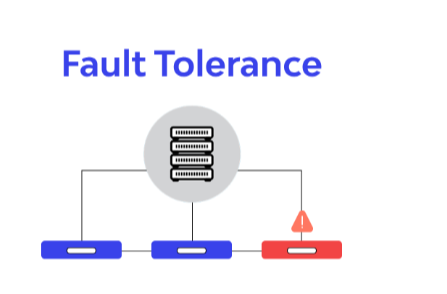Why Fault-Tolerant SAN Architecture Matters for Business Continuity

Understanding Fault-Tolerant SAN Architecture
Modern organizations rely on uninterrupted access to their data for daily operations, customer satisfaction, and regulatory compliance. From internal processes like payroll or reporting to external-facing applications that customers use to engage with products and services, data must always be accessible. A Storage Area Network (SAN) creates a dedicated, high-speed network connecting servers to shared storage devices, enabling efficient data storage and resilient access. Unlike direct-attached storage, SANs separate storage traffic from general network communication, reducing latency and bottlenecks, and improving scalability as organizations grow.
A fault-tolerant SAN architecture is designed to ensure that even if individual components fail, critical data resources remain accessible. It achieves this by incorporating redundancy into every aspect of the storage infrastructure, from hardware to network paths. By isolating storage traffic from regular network operations and delivering robust performance, fault-tolerant SANs offer businesses a rock-solid backbone for their data infrastructure, ensuring that storage interruptions are minimized, even in complex IT environments. These systems use redundant hardware, automated failover processes, and proactive monitoring, enabling organizations to minimize interruptions and data loss. Ultimately, fault-tolerant SANs empower companies to maintain business continuity despite unexpected hardware and software failures.
The Cost of Downtime
IT downtime can lead to significant financial harm, far beyond immediate productivity losses. Industry reports indicate that outages costing over $1 million have become more common, with nearly a quarter of business leaders experiencing such incidents in recent years. A single hour of downtime can set back organizations with direct losses and missed business opportunities, delayed customer service, and long-term damage to brand credibility.
Lost productivity, reputational damage, and the risk of data loss underscore the value of building highly resilient storage solutions. Data loss can trigger fines or lawsuits in regulated industries, multiplying the business impact of technical failures. As digital dependence grows and cloud adoption accelerates, so does the need to avoid unplanned interruptions that can undermine business continuity. A proactive approach to SAN architecture, emphasizing fault tolerance, is crucial to protect against these costly disruptions.
See Also: Master the linear downward gradient filling technique of WPS table to improve data visualization
Key Components of a Fault-Tolerant SAN
- Redundant Hardware: Duplication of storage controllers, disk drives, SAN switches, and power supplies guarantees that no single point of failure disrupts operations. Each component has a backup that automatically takes over, ensuring ongoing connectivity and data access.
- Automated Failover Mechanisms: Intelligent systems instantly reroute workloads to healthy components in case of hardware malfunctions, minimizing disruption. Failover can be configured at multiple layers, including network paths, storage controllers, and data centers.
- Data Replication: Data can be replicated synchronously or asynchronously across multiple devices or sites, ensuring data consistency and availability. Replication strategies depend on risk tolerance and recovery objectives, with synchronous replication providing the highest consistency and asynchronous replication enabling disaster recovery across geographies.
- Regular Monitoring and Maintenance: Proactive system health checks and monitoring enable rapid responses to developing issues, reducing the chance of an outage. Advanced analytics can predict component failures, allowing IT teams to replace parts before they cause service interruptions.
Benefits of Implementing Fault-Tolerant SAN Architecture
Deploying a resilient SAN infrastructure yields substantial benefits for businesses, both in measurable financial terms and in strategic flexibility:
- Continuous Operations: Always-available applications maintain productivity and meet customer expectations, even during hardware upgrades or component failures. Operational continuity means business processes can proceed uninterrupted, contributing to long-term enterprise stability.
- Data Integrity: Advanced replication strategies and redundancy protect against accidental loss or corruption. In scenarios where transactions occur in real time, such as banking or healthcare, maintaining accurate data records is essential for user trust and compliance.
- Regulatory Compliance: Highly available storage helps meet industry regulatory data protection and retention requirements. Many sectors impose strict uptime and reporting standards, making fault tolerance an integral element of compliance strategy.
- Competitive Advantage: Demonstrates to clients and partners that your organization values reliability and preparedness. Businesses delivering uninterrupted services are more likely to earn new contracts and retain customer loyalty, especially in sectors where downtime is unacceptable.
Best Practices for Building a Fault-Tolerant SAN
- Assess Business Requirements: Begin by thoroughly evaluating your organization’s unique needs and prioritizing applications and workflows that cannot tolerate outages. Understanding which systems are mission-critical will help guide the design of the SAN and direct resources where they are most needed.
- Implement Redundancy: Add backup paths for all critical hardware and network components. This redundancy is necessary to avoid single points of failure at every stage, from storage arrays to cabling and switches. Dual-power supplies, multi-path networking, and hot-swappable drives are all part of resilient design.
- Regular Testing: Schedule simulation exercises to assess your SAN’s response to component faults and validate failover processes. Regular testing identifies configuration issues and ensures your team is prepared and can act swiftly in the event of real-world failures.
- Stay Updated: Apply firmware and software updates promptly to benefit from security patches, bug fixes, and feature enhancements that improve reliability. Outdated systems often harbor vulnerabilities or incompatibilities that can trigger otherwise preventable failures.
Conclusion
A fault-tolerant SAN architecture is fundamental for safeguarding your organization’s operational resiliency. It is a strategic investment that protects against the costly repercussions of downtime, data loss, and service interruptions. In an era where digital infrastructure underpins every aspect of business, prioritizing SAN reliability ensures that your organization is prepared for everyday challenges and unplanned disruptions.
By embracing best practices and leveraging modern technologies, businesses can maintain continuity, foster trust with clients and partners, and secure a lasting competitive advantage. Forward-thinking IT leaders recognize that fault tolerance is not merely an IT objective but a business imperative tied directly to customer experience, bottom-line efficiency, and brand reputation.




